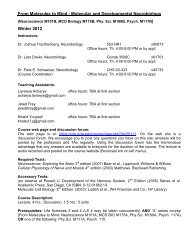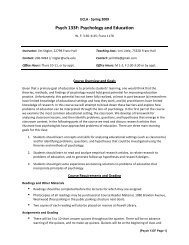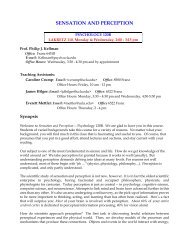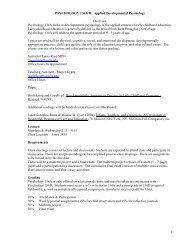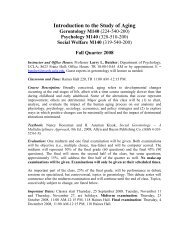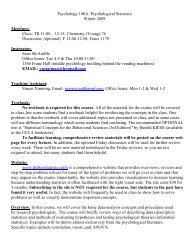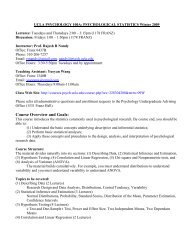Psych 240A Winter 2012 syllabus 5 - Courses in Psychology - UCLA
Psych 240A Winter 2012 syllabus 5 - Courses in Psychology - UCLA
Psych 240A Winter 2012 syllabus 5 - Courses in Psychology - UCLA
You also want an ePaper? Increase the reach of your titles
YUMPU automatically turns print PDFs into web optimized ePapers that Google loves.
F<strong>in</strong>al Papereach of the four writ<strong>in</strong>g assignments, rate their quality, and provide some writtenfeedback to the authors.40% of the grade will be based on a f<strong>in</strong>al paper. The f<strong>in</strong>al paper will be due one week after thef<strong>in</strong>al class, and will likely consist of a brief research proposal, <strong>in</strong>clud<strong>in</strong>g a statement of theproblem, the specific research question, a review of a few relevant studies, and a researchdesign. Paper topics should be discussed with one of the <strong>in</strong>structors and approved <strong>in</strong> advance.Our philosophy is that the paper you write should, <strong>in</strong> some way, move you along your careerpath. Thus, we will be flexible on the type of paper you write. Please talk with one of the<strong>in</strong>structors as you develop your paper topic.Schedule of Classes1/13 Introduction to the Course (class starts at 10:15 this day only)1/20 Foundations of Development <strong>in</strong> Infancy: Methods and Theory• Asl<strong>in</strong>, R. N. (2007). What’s <strong>in</strong> a look? Developmental Science, 10, 48-53.• Johnson, S. P. (2010). How <strong>in</strong>fants learn about the visual world. Cognitive Science,34, 1158-1184.• Spelke, E. S. & K<strong>in</strong>zler, K. D. (2007). Core knowledge. Developmental Science,10, 89–96.• Spencer, J. P., Blumberg, M. S., McMurray, B., Rob<strong>in</strong>son, S. R., Samuelson, L.K., and Tombl<strong>in</strong>, J. B. (2009). Short arms and talk<strong>in</strong>g eggs: Why we should nolonger abide the nativist–empiricist debate. Child Development Perspectives, 3, 79-87.1/27 Perceptual Development <strong>in</strong> Infancy• Bhatt, R. S., & Qu<strong>in</strong>n, P. C. (2011). How does learn<strong>in</strong>g impact development <strong>in</strong><strong>in</strong>fancy? The case of perceptual organization. Infancy, 16, 2-38.• Saffran, J. R., Asl<strong>in</strong>, R. N., & Newport, E. L. (1996). Statistical learn<strong>in</strong>g by 8-monthold<strong>in</strong>fants. Science, 274, 1926-1928.• Kirkham, N. Z., Slemmer, J. A., & Johnson, S. P. (2002). Visual statistical learn<strong>in</strong>g<strong>in</strong> <strong>in</strong>fancy: Evidence for a doma<strong>in</strong> general learn<strong>in</strong>g mechanism. Cognition, 83, B35-B42.• Werker, J. F., & Tees, R. C. (2002). Cross-language speech perception: Evidencefor perceptual reorganization dur<strong>in</strong>g the first year of life. Infant Behavior &Development, 25, 121-133.2/3 Social Development <strong>in</strong> Infancy• Haml<strong>in</strong>, J. K., Wynn, K., & Bloom, P. (2007). Social evaluation by preverbal <strong>in</strong>fants.Nature, 450, 557-560.• Farroni, T., Csibra, G., Simion, F., & Johnson, M. H. (2002). Eye contact detection<strong>in</strong> humans from birth. Proceed<strong>in</strong>gs of the National Academy of Sciences (USA), 99,9602-9605.• Frank, M. C., Vul, E., & Johnson, S. P. (2009). Development of <strong>in</strong>fants’ attention tofaces dur<strong>in</strong>g the first year. Cognition, 110, 160-170.• Kuhl, P. K. (2004). Early language acquisition: Crack<strong>in</strong>g the speech code. Nature<strong>Psych</strong> <strong>240A</strong> <strong>2012</strong> – Page 2



